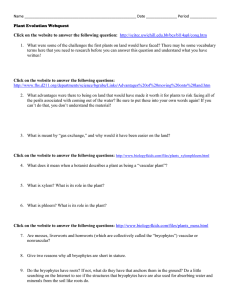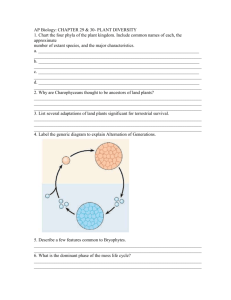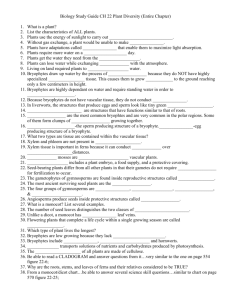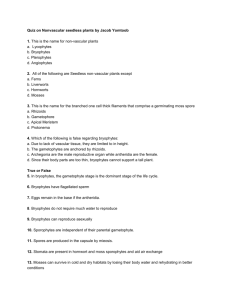Document 13310705
advertisement
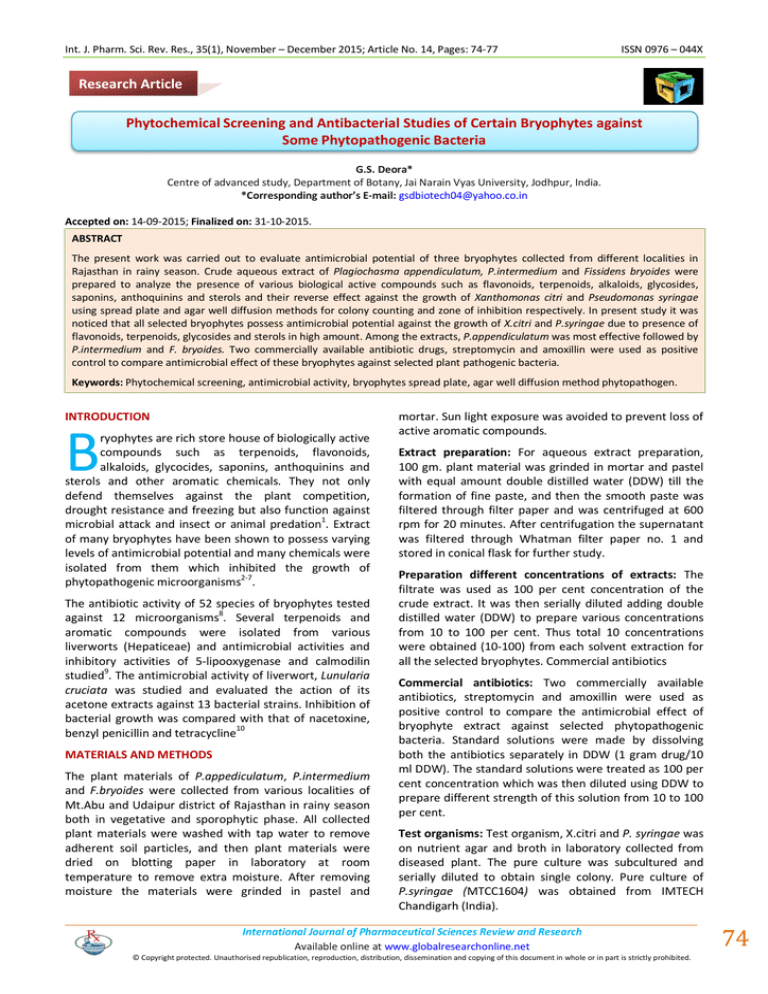
Int. J. Pharm. Sci. Rev. Res., 35(1), November – December 2015; Article No. 14, Pages: 74-77 ISSN 0976 – 044X Research Article Phytochemical Screening and Antibacterial Studies of Certain Bryophytes against Some Phytopathogenic Bacteria G.S. Deora* Centre of advanced study, Department of Botany, Jai Narain Vyas University, Jodhpur, India. *Corresponding author’s E-mail: gsdbiotech04@yahoo.co.in Accepted on: 14-09-2015; Finalized on: 31-10-2015. ABSTRACT The present work was carried out to evaluate antimicrobial potential of three bryophytes collected from different localities in Rajasthan in rainy season. Crude aqueous extract of Plagiochasma appendiculatum, P.intermedium and Fissidens bryoides were prepared to analyze the presence of various biological active compounds such as flavonoids, terpenoids, alkaloids, glycosides, saponins, anthoquinins and sterols and their reverse effect against the growth of Xanthomonas citri and Pseudomonas syringae using spread plate and agar well diffusion methods for colony counting and zone of inhibition respectively. In present study it was noticed that all selected bryophytes possess antimicrobial potential against the growth of X.citri and P.syringae due to presence of flavonoids, terpenoids, glycosides and sterols in high amount. Among the extracts, P.appendiculatum was most effective followed by P.intermedium and F. bryoides. Two commercially available antibiotic drugs, streptomycin and amoxillin were used as positive control to compare antimicrobial effect of these bryophytes against selected plant pathogenic bacteria. Keywords: Phytochemical screening, antimicrobial activity, bryophytes spread plate, agar well diffusion method phytopathogen. INTRODUCTION B ryophytes are rich store house of biologically active compounds such as terpenoids, flavonoids, alkaloids, glycocides, saponins, anthoquinins and sterols and other aromatic chemicals. They not only defend themselves against the plant competition, drought resistance and freezing but also function against microbial attack and insect or animal predation1. Extract of many bryophytes have been shown to possess varying levels of antimicrobial potential and many chemicals were isolated from them which inhibited the growth of phytopathogenic microorganisms2-7. The antibiotic activity of 52 species of bryophytes tested 8 against 12 microorganisms . Several terpenoids and aromatic compounds were isolated from various liverworts (Hepaticeae) and antimicrobial activities and inhibitory activities of 5-lipooxygenase and calmodilin studied9. The antimicrobial activity of liverwort, Lunularia cruciata was studied and evaluated the action of its acetone extracts against 13 bacterial strains. Inhibition of bacterial growth was compared with that of nacetoxine, benzyl penicillin and tetracycline10 MATERIALS AND METHODS The plant materials of P.appediculatum, P.intermedium and F.bryoides were collected from various localities of Mt.Abu and Udaipur district of Rajasthan in rainy season both in vegetative and sporophytic phase. All collected plant materials were washed with tap water to remove adherent soil particles, and then plant materials were dried on blotting paper in laboratory at room temperature to remove extra moisture. After removing moisture the materials were grinded in pastel and mortar. Sun light exposure was avoided to prevent loss of active aromatic compounds. Extract preparation: For aqueous extract preparation, 100 gm. plant material was grinded in mortar and pastel with equal amount double distilled water (DDW) till the formation of fine paste, and then the smooth paste was filtered through filter paper and was centrifuged at 600 rpm for 20 minutes. After centrifugation the supernatant was filtered through Whatman filter paper no. 1 and stored in conical flask for further study. Preparation different concentrations of extracts: The filtrate was used as 100 per cent concentration of the crude extract. It was then serially diluted adding double distilled water (DDW) to prepare various concentrations from 10 to 100 per cent. Thus total 10 concentrations were obtained (10-100) from each solvent extraction for all the selected bryophytes. Commercial antibiotics Commercial antibiotics: Two commercially available antibiotics, streptomycin and amoxillin were used as positive control to compare the antimicrobial effect of bryophyte extract against selected phytopathogenic bacteria. Standard solutions were made by dissolving both the antibiotics separately in DDW (1 gram drug/10 ml DDW). The standard solutions were treated as 100 per cent concentration which was then diluted using DDW to prepare different strength of this solution from 10 to 100 per cent. Test organisms: Test organism, X.citri and P. syringae was on nutrient agar and broth in laboratory collected from diseased plant. The pure culture was subcultured and serially diluted to obtain single colony. Pure culture of P.syringae (MTCC1604) was obtained from IMTECH Chandigarh (India). International Journal of Pharmaceutical Sciences Review and Research Available online at www.globalresearchonline.net © Copyright protected. Unauthorised republication, reproduction, distribution, dissemination and copying of this document in whole or in part is strictly prohibited. 74 © Copyright pro Int. J. Pharm. Sci. Rev. Res., 35(1), November – December 2015; Article No. 14, Pages: 74-77 Phytochemical screening: The aqueous extracts of all three selected bryophytes were subjected to various phytochemical tests to detect the presence of certain 11,12. bioactive compounds Bioassay of antimicrobial activity Spread plate assay for colony count experiment For spread plate assay serial dilution of bacterial cultures was done. For this 1ml.of 24 hr old bacterial broth culture was taken and diluted up to10-2 dilutions. 10 µl of this dilution was then spread evenly over the surface of solidified agar medium containing plant extracts and antibiotic solutions of different concentrations in each Petri plate in a ratio of 1:1 to compare antibacterial effect of plant extracts and antibiotic drugs. All the Petri plates were sealed with Para film and incubated at 30 °C for 24 hrs after which bacterial colonies were counted in each case. The tests were carried out in triplicate with negative control, DDW for each case. Agar well diffusion experiments. assay for inhibition zone Solidified medium was punched with a three millimeters diameter well using a sterile cork borer and then inoculated with 100 µL of 24 hrs. old broth culture of test microorganisms. The bacterial solution was evenly spread on the medium surface than the well was filled with100 µL of the plant extract /antibiotic solutions of different concentrations. The plates were sealed with Para film and incubated at 30 °C for 24 hrs. The antibacterial activity was calculated by measuring the diameter of inhibition zone appeared after incubation period. The tests were carried out in triplicate with a negative control for each set. ISSN 0976 – 044X RESULTS AND DISCUSSION Phytochemical Screening Results on phytochemical screening of selected bryophytes showed that terpenoids, flavonoids, sterols and glycosides were present in all three tested bryophytes where as alkaloids, saponins and anthoquinin were not reported. (Table-1). Evaluation of antibacterial activity Aqueous extracts showed positive effect against both the selected bacterial strains. Further it was observed that crude aqueous extract of P. appendiculatum was comparatively more effective in case of X. citri with minimum(16.0) number of colonies followed by P. intermedium 21.1 and F. bryoides 24.1 in 100 per cent concentrations in comparison to the control. Similar pattern of results were obtained in case of zone of inhibition in different concentrations of extracts of all three bryophytes. Zone of inhibition was maximum (49.6) in P. appendiculatum extract followed by P. intermedium (42.9) and F. bryoides (36.9) in 100 per cent concentration in comparison to its control (Table-2, 3). Table-2 Number of colonies of Xanthomonas citri in aqueous crude extracts of Plagiochasma appendiculatum, P. intermedium and Fissidens broides after 24 hrs.of incubation at 30°0C. In case of P. syringae it was reported that extracts of all three bryophytes were effective against bacterial growth but slightly less effective as in X. citri. Number of colonies of P. syringae was 26.2 followed by 27.3 and 29.3 in P. appendiculatum, P. intermedium and F. bryoides respectively in 100 per cent aqueous extract concentrations. Similarly zone of inhibition was maximum (34.5) in P. appendiculatum followed by P. intermedium (30.5) and F.bryoides (25.0). Table 1: Phytochemical profile of selected bryophytes Results Active compounds Alkaloids Phytochemical tests Observations Mayers test No precipitation Hagers test No precipitation Plagiochasma appendiculatum Plagiochasma intermedium Fissidens bryoides - - - Anthroquinin Borntragers test No layer formation - - - Cardia glycocides Keller Killeni test Brown ring ++ ++ + Flavanoids Ferric chloride test Lead acetate Alkaline reagent test Sodium hydrochloride test Green colour Yellow precipitate Yellow florescent test Yellow colour ++ ++ ++ ++ + ++ ++ + ++ + + + Saponins Froth test No froth formation - - - Salkowaski test LiebermannBurchardt test Reddish brown colour Brown ring ++ ++ + Sterols ++ ++ ++ Salkowaski test Lower layer turned yellow ++ + ++ Deep red colour + ++ ++ Terpenoids LiebermannBurchardt test Note: Results based on mean of three replicates. International Journal of Pharmaceutical Sciences Review and Research Available online at www.globalresearchonline.net © Copyright protected. Unauthorised republication, reproduction, distribution, dissemination and copying of this document in whole or in part is strictly prohibited. 75 © Copyright pro Int. J. Pharm. Sci. Rev. Res., 35(1), November – December 2015; Article No. 14, Pages: 74-77 ISSN 0976 – 044X Table 2: Number of colonies of Xanthomonas citri in aqueous crude extracts of Plagiochasma appendiculatum, P. intermedium and Fissidens broides after 24 hrs. of incubation at 30°C. S. No. Concentration % Streptomycin Amaxillin P. appendiculatum P. intermedium F. bryoides 1 Control 97.0 97.0 97.0 97.0 97.0 2 10 78.3 79.2 89.1 90.0 92.3 3 20 67.1 69.4 77.0 82.0 85.1 4 30 58.4 61.7 68.2 76.1 70.5 5 40 47.6 50.1 56.5 61.4 65.6 6 50 33.4 34.4 42.3 52.6 54.9 7 60 24.3 26.6 36.6 43.5 45.2 8 70 18.2 20.3 27.8 37.3 39.7 9 80 13.3 14.5 22.1 29.2 32.3 10 90 9.1 10.6 18.9 26.0 28.7 11 100 6.2 8.0 16.0 21.1 24.1 Note: Results based on mean of three replicates Table 3: Zone of inhibition of Xanthomonas citri in aqueous crude extract of Plagiochasma appendiculatum, P. intermedium and Fissidens broides after 24 hrs. of incubation at 30°C S. No. Concentration % Streptomycin Amaxillin P. appendiculatum P. intermedium F. bryoides 1 Control 00 00 00 00 00 2 10 36.2 12.6 10.1 9.0 7.0 3 20 37.3 14.6 12.0 10.8 7.3 4 30 40.0 16.1 14.1 12.1 10.6 5 40 41.2 24.9 16.2 14.4 11.2 6 50 43.1 30.7 17.9 15.3 12.0 7 60 46.0 40.3 19.1 17.5 14.7 8 70 57.2 51.4 25.6 22.7 16.8 9 80 68.3 62.6 31.7 24.4 20.2 10 90 77.6 72.3 40.1 30.2 24.3 11 100 89.0 81.1 49.6 42.9 36.6 Note: Results based on three replicates. Table 4: Number of colonies of P.syringae in aqueous crude extracts of Plagiochasma appendiculatum, P.intermedium, and Fissidens bryoides after 24 hrs. of incubation at 30 °C. S. No. Concentrations % Streptomycin Amoxillin Pa Pi Fb 1 Control 96 96 96 96 96 2 10 77.2 88.3 90.0 92.1 93.0 3 20 58.3 71.1 82.2 88.4 88.6 4 30 47.7 68.3 88.3 87.5 88.9 5 40 34.5 57.0 71.4 73.3 74.1 6 50 25.1 45.6 61.3 62.6 63.0 7 60 20.0 32.1 51.2 53.4 54.1 8 70 15.4 25.0 42.0 43.1 44.1 9 80 12.6 24.1 36.4 40.0 41.6 10 90 10.4 22.7 32.1 34.3 37.2 11 100 8.0 18.3 26.2 27.3 29.3 Note: Results based on mean of three replicates. International Journal of Pharmaceutical Sciences Review and Research Available online at www.globalresearchonline.net © Copyright protected. Unauthorised republication, reproduction, distribution, dissemination and copying of this document in whole or in part is strictly prohibited. 76 © Copyright pro Int. J. Pharm. Sci. Rev. Res., 35(1), November – December 2015; Article No. 14, Pages: 74-77 ISSN 0976 – 044X Table 5: Zone of inhibition (in mm) of Pseudomonas syringae in aqueous crude extract of P.appendiculatum, P.intermedium and F.bryoides. S.No. % Concentrations Streptomycin Amoxillin Pa Pi Fb 1 Control 00 00 00 00 00 2 10 38.2 13.5 9.2 9.0 7.6 3 20 39.7 14.1 10.1 9.6 8.1 4 30 40.3 15.3 11.3 11.0 9.2 5 40 43.1 22.4 11.6 12.0 10.1 6 50 46.3 37.0 14.0 13.1 11.0 7 60 50.0 37.0 17.3 15.5 13.0 8 70 57.1 47.2 20.4 18.4 15.2 9 80 66.0 59.3 26.1 22.0 18.6 10 90 77.1 71.5 30.0 26.0 22.4 11 100 90.0 76.6 34.5 30.5 25.0 Note: Results based on mean of three replicates. Various concentrations of commercially available antibiotics, streptomycin and amoxillin tested against both the bacterial strains were quite potent than the extracts of plants. 3. Xie C.F. and H.X. Lou. Chemical constituents from the Chinese bryophytes and their reversal of fungal resistance. Curr.Org.Chem. 12612-628. 4. Singh M., Rawat A.K. and Govindarajan. Antimicrobial activity of some Indian mosses. Fitoterapia, 78, 2007, 156158. 5. Deora G.S. and Vishwakarma G. Phytochemical screening and antimicrobial activity of Plagiochasma intermedium J .Pure and Applied Microbiology, 6(2), 2012, 869-874. 6. Deora G.S., Bhati D. and Narendra S. Jain. Antibiotic effects of certain bryophytes on Agrobacterium tumifaciens. J.Pure and Applied Microbiology, 1(2), 2007, 2015-219. 7. Deora G.S., Bhati, D. Evaluation of antimicrobial activity of alcoholic crude extract of Anthoceros longii-A bryophyte on Xanthomonas citri. J. Phytol Res. 2, 281-183. 8. Banerjee R.D. and Sen., S. P. Antibiotic activity of bryophytes. The bryologist, 82(2), 1979, 141-153. 9. Asakawa, T. Highlight in phytochemistry of hepaticeae biologically active terpenoids and aromatic compounds. Pure and Applied Che. 66(10/11), 1994, 2193-2196. Among the antibiotics streptomycin was more effective than the amoxillin in both the cases. Bryophytes are the potent source of various bioactive compounds and show antimicrobial activity against phytopathogenic microbes and suggested that these plants may be a potent tool to control different plant diseases caused by microbes instead of using synthetic chemicals13,14. Antimicrobial activity of liverwort Lunularia cruciata extracts against 13 bacterial strains. Inhibition of bacterial growth was compared with the nacefotoxine, benxyl penicillin and tetracycline and reported similar results15. CONCLUSION Results of this study indicated the presence of active biological compounds such as terpenoids, flavonoids, sterols and glycosides. Further these results suggest that these chemical compounds could be potent antimicrobial agents to treat plant associated diseases such as Citrus canker and Bean blight caused by Xanthomonas citri and Pseudomonas syringae respectively. REFERENCES 1. 2. Xie, C.F. and H.X. Lou. Secondary metabolites in some bryophytes. An ecological aspect. Chem. Biodivers, 6, 2009, 303-312. Mewari N. and Kumar P. Antimicrobial activity of Marchantia polymorpha. Pharmaceutical biology, 46(1011), 2008, 19-822. 10. Basil, A. Antibacterial activity in Rhynechostegium riparoides (Hedw.). Card. Extract (bryophyte). Phyto. Res. 12(S1), 46-48. th 11. Evans, W.C.Pharmacology, 14 edn. Hart court Brace and Company, Asia Pvt. Ltd. Singapore. 2006. 12. Ramaan, N.Phytochemical techniques, New India Pub. Agency, 2006. 13. Deora G.S. Deora and Rathore M.S. Antimicrobial activity of bryophytes. J.Bioscience and Biotech.Res.Asia, 10(2), 2013, 705-710. 14. Deora G.S. and Guhil N. Bryophytes: A potent tool for controlling some fungal diseases of crop plants. IJPSI, 3(6), 2014, 21-26. 15. Deora G.S. and Guhil N. Phytochemical analysis and antimicrobial activity of moss Bryum cellulare against some phytopathogenic fungi. IJPSR, 6(2), 2015, 688-691. Source of Support: Nil, Conflict of Interest: None. International Journal of Pharmaceutical Sciences Review and Research Available online at www.globalresearchonline.net © Copyright protected. Unauthorised republication, reproduction, distribution, dissemination and copying of this document in whole or in part is strictly prohibited. 77 © Copyright pro
